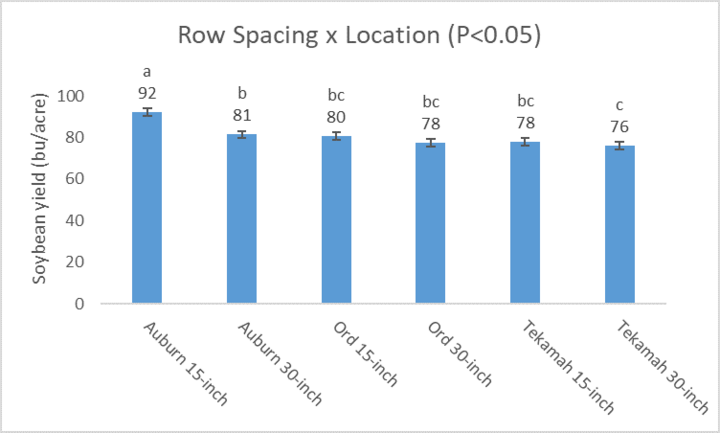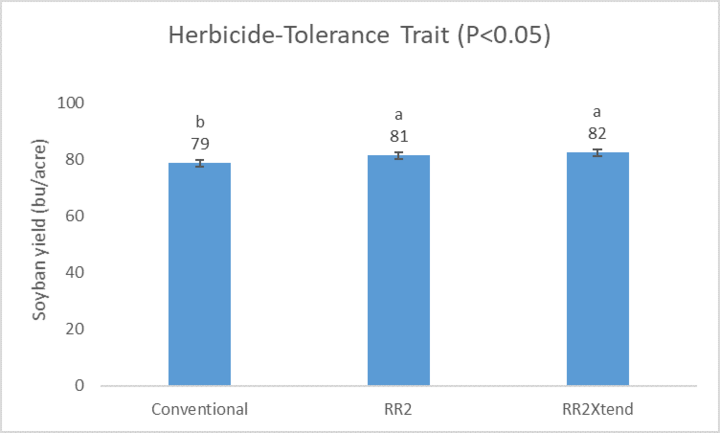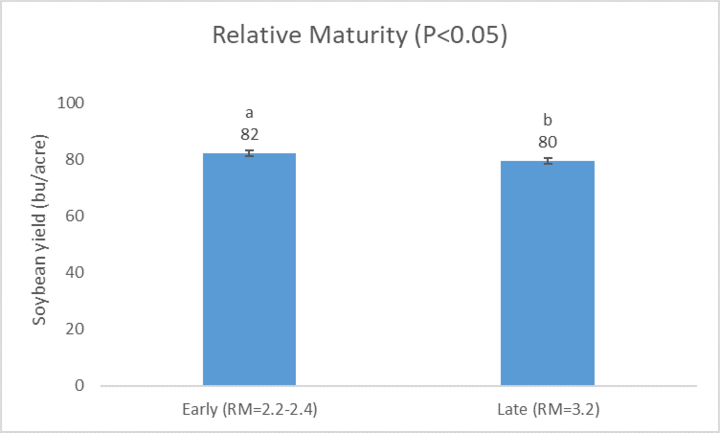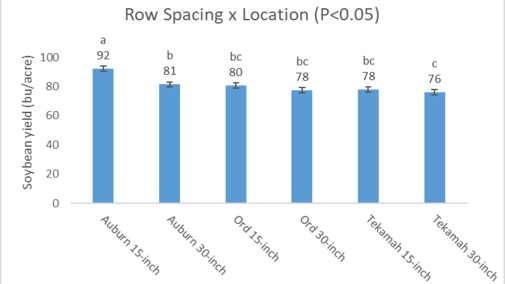In 2017, the Xtend soybean (RR2Xtend) and approved formulations for over-the-top dicamba application technology became available to soybean producers in the United States, providing a set of new genetics and another weed management tool.
Take-Home Points
- The effect of narrow row spacing on yield was site specific; 15-inch and 30-inch soybean yields were similar at Ord and Tekamah, but 15-inch yields were higher at Auburn.
- Conventional varieties yielded an average two to three bushels less than RR2 and RR2Xtend varieties.
- Early maturity soybean varieties (RM=2.2-2.4) yielded an average of 2 more bushels when compared to the late season varieties (RM = 3.2).
- Combined, these results indicate that
- narrow row spacing (15-inch) presents a potential for yield increase,
- conventional varieties yielded slightly less than RR2 and RR2Xtend varieties, and
- early season varieties yielded slightly more than late season varieties.
Comparable Yields. Given the higher seed prices of herbicide-tolerant soybean varieties (e.g., RR2 and RR2Xtend) compared to conventional varieties, widespread occurrence of glyphosate-resistant weeds in Nebraska, concerns with dicamba off-target movement when spraying RR2Xtend acres, and premiums for non-GMO soybeans, some growers have considered including conventional soybean varieties as part of their cropping systems. Some of the challenges associated with growing conventional soybeans are:
- Seed availability and variety selection
- Misapplication and drift of glyphosate and/or dicamba to non-tolerant varieties
- Weed management without the use of glyphosate post-emergence (which most of us have become accustomed to)
- Continual scouting and timely spraying of fields
A common question among producers is whether conventional varieties can provide yields similar to RR2 and RR2Xtend varieties, which dominate the market and have been the main focus of current breeding programs.
Row Spacing. According to a survey conducted in 2016, 30-inch row spacing has been the standard for most growers across Nebraska; however; research has shown a potential yield increase when soybeans are planted at a 15-inch row spacing. Moreover, narrow-row spacing has been reported to reduce the likelihood of weed resurgence in soybeans due to the faster rate of canopy closure.
Cover Crops. The survey also indicated that cover crops have increased in popularity among Nebraska growers and that reduced erosion and lower weed pressure have been observed where cover crops have been adopted.
Soybean Maturities. Selecting soybean varieties with shorter relative maturity would allow for earlier planting of a cover crop in the fall, which would enhance cover crop biomass production, soil protection, and weed suppression in the winter and spring.
Study Objective
Thus, herbicide tolerance trait, row spacing, maturity group, and cover crops are strategies that could be better explored by Nebraska growers to maximize soybean yield potential while enhancing weed management. As part of the 2017 Soybean Management Field Days, we conducted a study to explore the impact of herbicide tolerance trait selection, maturity group, and row spacing on soybean yield.
Research Questions
- When treated the same, are the yields of conventional, RR2, and RR2Xtend varieties similar?
- Do these varieties respond similarly to different row spacing?
- Does maturity group play a role in the yield potential?
Methods
| Row Spacing1 | Maturity Group | Herbicide Tolerance Trait2 |
|---|---|---|
| 15-inch | Early (2.2-2.4) | Conventional (U11-920017 & AG3253) |
| 30-inch | Late (3.2) | RR2 (AG2431R2Y & AG3231) |
| RR2 Xtend (AG24X7 & AG32X7) | ||
|
1 125,000 seeds per acre was the seeding rate for the 15-inch and 30-inch treatments. |
||
In an attempt to answer these research questions, a study was established at three of the 2017 Soybean Management Field Day locations. At Auburn, Ord, and Tekamah soybeans were planted on 05/09, 05/15, and 05/08, respectively; silty clay loam was the soil type at all sites. The study was conducted as a 2x2x3 factorial with a total of 12 treatments replicated four times arranged on a randomized complete block design. Plots were 4 rows wide (10 ft) and 30 ft long. Treatments consisted of:
- Row spacing: 15-inch versus 30-inch
- Maturity groups: early (2.2-2.4) versus late (3.2)
- Herbicide tolerance traits: conventional, RR2, and RR2Xtend
Varieties were all managed as conventional soybeans for weed management (i.e., no glyphosate or dicamba sprayed post-emergence). See Table 1 for variety information.
Grain yield data. Yields, in bushels per acre, were determined with a small plot combine by harvesting two center rows of each plot after they were cut to a standard length of 30 ft. Yields were adjusted to 13% grain moisture for final reported values.
Statistical analysis. The experimental data were analyzed to evaluate interaction and main treatment effects on yield. Significant differences were determined based on a probability of 0.95.
Results and Discussion
According to the statistical analysis, location by row spacing was the only significant interaction (PFigure 1). The experimental factors herbicide tolerance trait and maturity group were significant (PFigures 2 and 3).
Row Spacing and Study Location
Soybean yield response to row spacing varied across locations (data pooled across maturity groups and herbicide tolerance trait varieties; Figure 1). The 15-inch row spacing soybeans yielded more than 30-inch at Auburn. At Ord and Tekamah, the yields were similar (P>0.05). Even though yield response to narrow row spacing was site-specific, 15-inch soybeans produced the same or more, never less, when compared to 30-inch soybeans. Higher yields in narrow-row spacing are likely due to faster canopy closure and greater light interception (e.g., plants “harvesting” more light for photosynthesis) due to a more even plant distribution in the field. Yields at Auburn were higher than Ord and Tekamah (average of 87, 79, and 77 bushels across treatments, respectively).

Figure 1. Soybean yield in response to study location and row spacing. Bars that do not share the same letter are significantly different (P
Herbicide Tolerance Variety Trait
Conventional varieties yielded an average two to three bushels less per acre than the RR2 and RR2Xtend varieties (data pooled across maturity groups, location and row spacing; Figure 2). Yields from RR2 and RR2Xtend were similar. Even though the conventional varieties yielded less, the difference was relatively small. Depending on premiums offered to non-GMO soybeans and overall weed management costs, which are directly related to the herbicide tolerance trait selected, they may result in equal or higher profitability.
Maturity Group
The early maturity varieties (RM 2.2-2.4) yielded two bushels more than the late maturity varieties (RM 3.2; data pooled across herbicide tolerance trait, location and row spacing). Thus, growers interested in cover crops could potentially use the early maturity varieties recommended for their regions to allow a wider window for cover crop establishment in the fall without hurting soybean yield potential.
Summary
This study was conducted at three Nebraska locations during the 2017 growing season. Fifteen-inch row spacing yielded the same or more than the standard 30-inch row spacing. The results of this study indicate a yield advantage with RR2 and RR2Xtend soybean varieties when compared to conventional soybeans. The early maturity group tested in this study (RM2.2-2.4) had a yield advantage when compared to the late maturity group (RM3.2).
To further validate our results, this study will be replicated at the four locations of the 2018 Soybean Management Field Days.
For complete information about this and additional studies conducted as part of the 2017 Soybean Management Field Days, please visit: https://ardc.unl.edu/2018SMFDResearchUpdateBooklet-CropProClinics.pdf


Acknowledgements
The authors would like to thank the students and technicians involved with the Soybean Management Field Day for their support with plot establishment and maintenance, and data collection. The Nebraska Soybean Board funded this program. Thanks to the growers who allowed us to establish this study on their farms.

